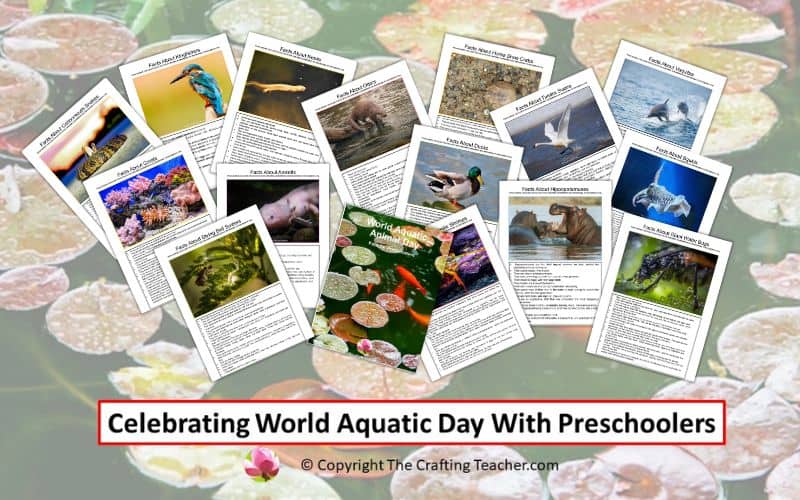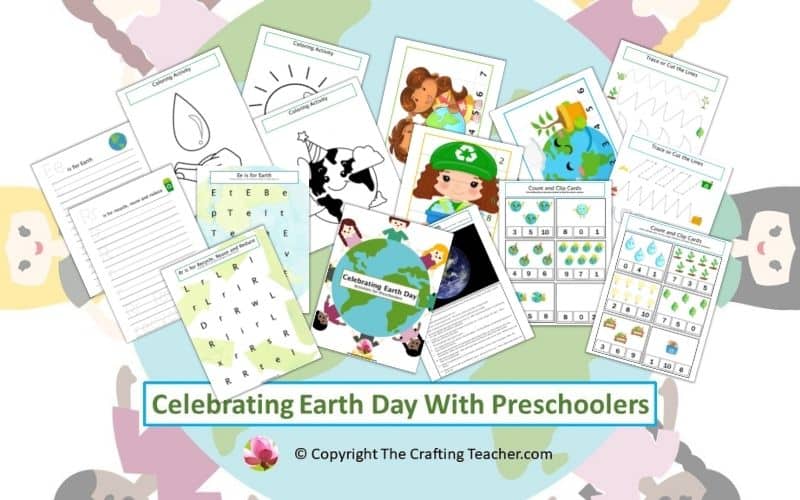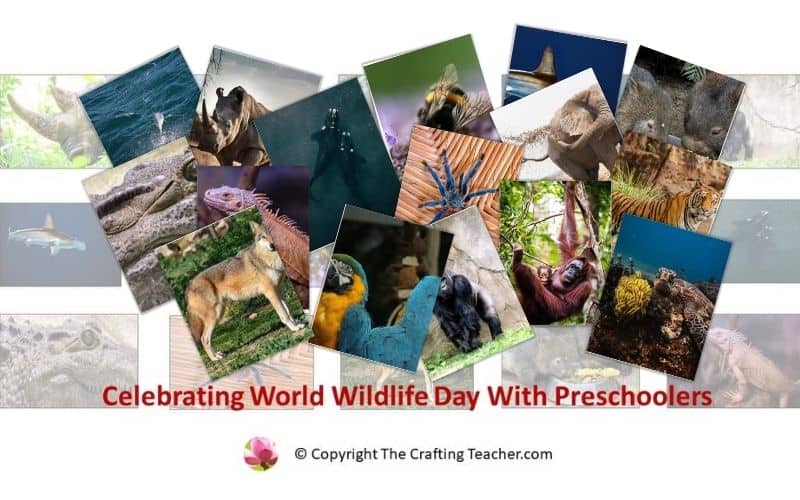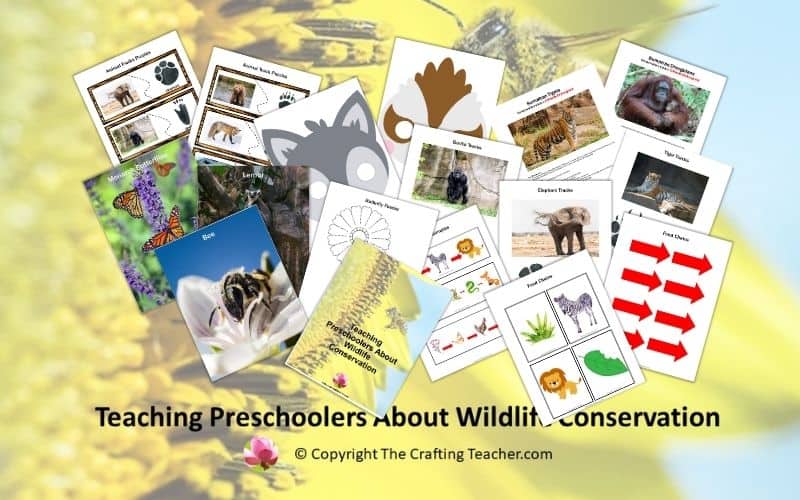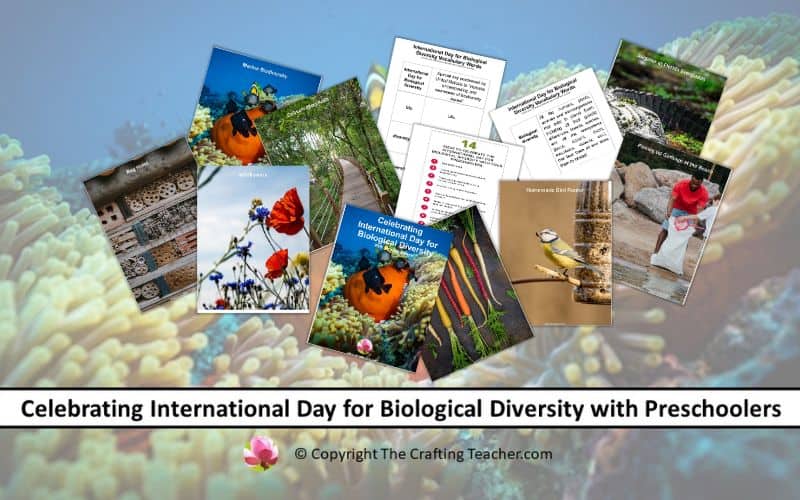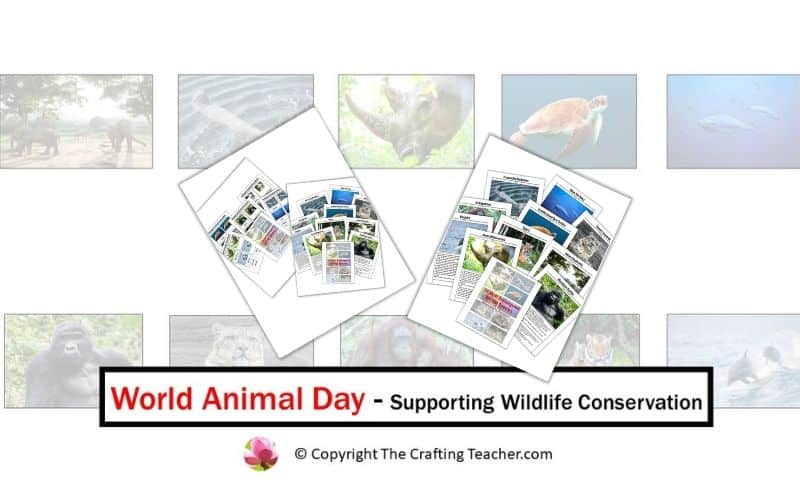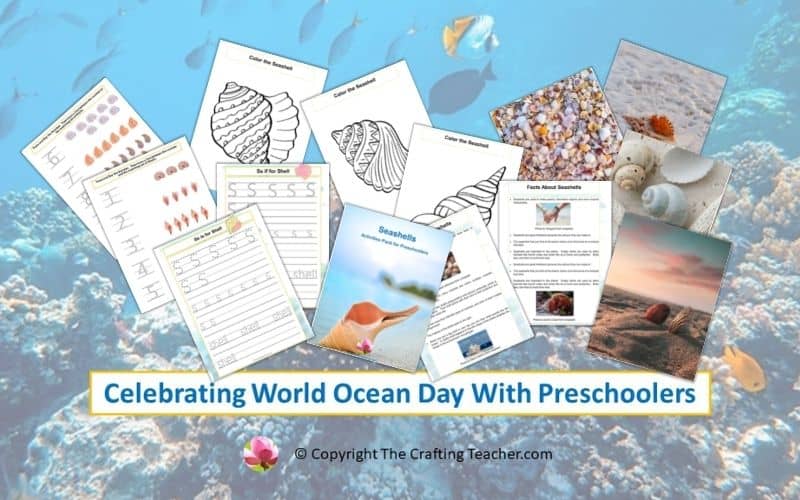Celebrating World Aquatic Animal Day With Preschoolers
Affiliate Disclosure: “This post contains affiliate links, which means I receive a small commission, at no extra cost to you, if you make a purchase using those links.”
World Aquatic Animal Day is celebrated on April 3rd, to call attention all over the world to the importance of all types of aquatic creatures that live in oceans, rivers, seas, lakes, and ponds, raise awareness about their importance in our ecosystems, and our survival, and find ways to protect them.
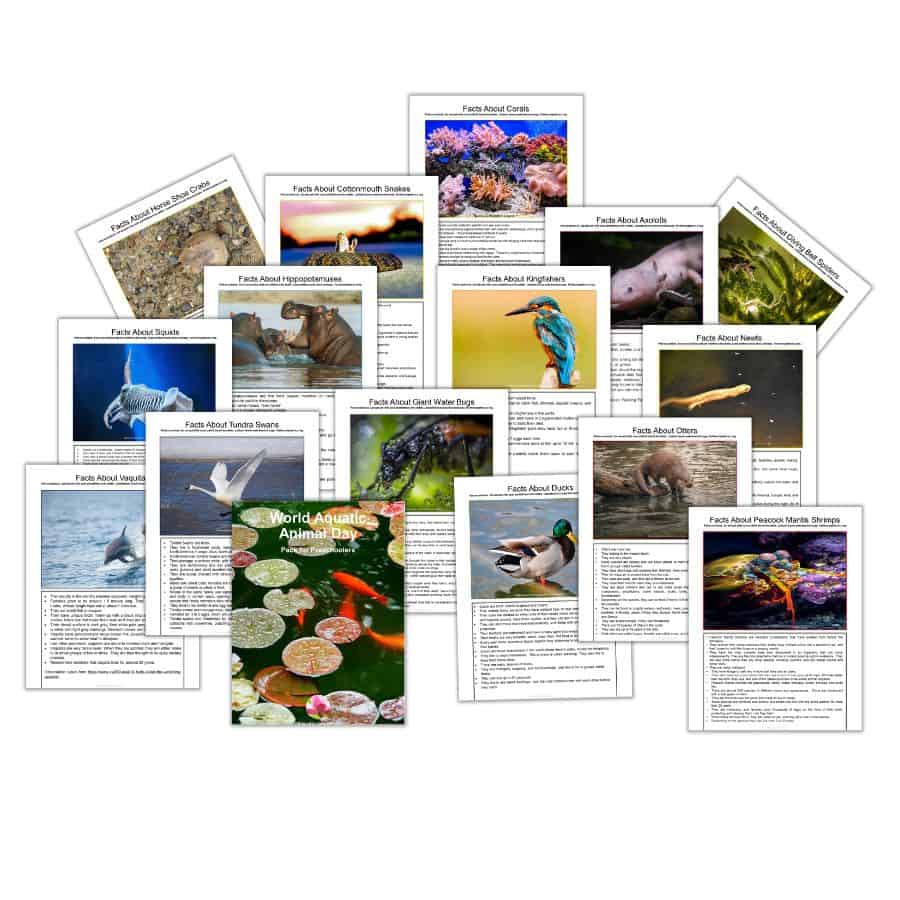
I’ve included a FREE 22-page long World Aquatic Animal Day Pack, with activities to do with your preschoolers. You can get it at the end of this post.
History of World Aquatic Animal Day
In 2008 the Lewis & Clark Law School in Portland, Oregon opened the Animal Law Clinic. Its mission was to graduate lawyers to protect animals using the law.
They noticed that human activities such as human waste, overfishing, and pollution were altering ecosystems and harming aquatic animals.
In 2020 the Animal Law Clinic created the World Aquatic Animal Day, to form a unifying front to educate and create laws and policies to protect these important animals.
Many organizations from around the world participated. One of those organizations is the World Organization for Animal Health (WOAH), which launched its first Aquatic Animal Health Strategy in May 2021 to “improve aquatic animal health and welfare worldwide, contributing to sustainable economic growth, poverty alleviation, and food security, thereby supporting the achievement of the Sustainable Development Goals.”
Importance of Aquatic Animals
The importance of aquatic animals is vital. Each of them plays a specific role in the ecosystem, to keep it healthy and thriving. They are responsible for:
- Producing over half of the oxygen land animals and humans breathe.
- Purifying water for drinking, and growing crops.
- Provide natural protection from flooding, controlling erosion.
- Recycling nutrients and disposing of waste.
- Be part of a complex food chain providing food for other animals and humans.
- Control the overpopulation of species to keep balance.
- Provide minerals and materials for medicine and energy.
- Employ millions of people in trade, shipping, tourism, fisheries, and travel.
- Storing carbon, and potentially reducing climate change.
- Provide sources of recreation for humans.
Unfortunately, human practices are seriously harming aquatic animals and producing changes in the climate and habitats. Among the most important causes are:
- Water contamination with heavy metals, oil spills, and pesticides.
- Plastic pollution, overfishing, and entanglements with nests and fishing lines.
- Strikes by water vehicles.
- Sport over hunting.
- Losing their habitat due to farming and building cities and highways.
Facts About Some Aquatic Animals
There are many different types of fish, crustaceans, amphibians, mollusks, insects, reptiles, birds, and even mammals, that live in freshwater environments, including rivers, lakes, ponds, and streams, but the majority of aquatic animals live in salt water.
Scientists have only explored 5% and very little of what we know about the secrets of the oceans. But, since more than 72% of our planet’s surface is covered by salt water, we already know that there are over 230,000 species living in the oceans.
Here are incredible facts about some aquatic species:
- Lionfish have spines on their backs, and their sting is extremely painful to humans, and sometimes even fatal.
- Freshwater turtles can live more than forty years.
- Irrawaddy, Tucuxi, South Asian, and Amazon, are freshwater dolphins.
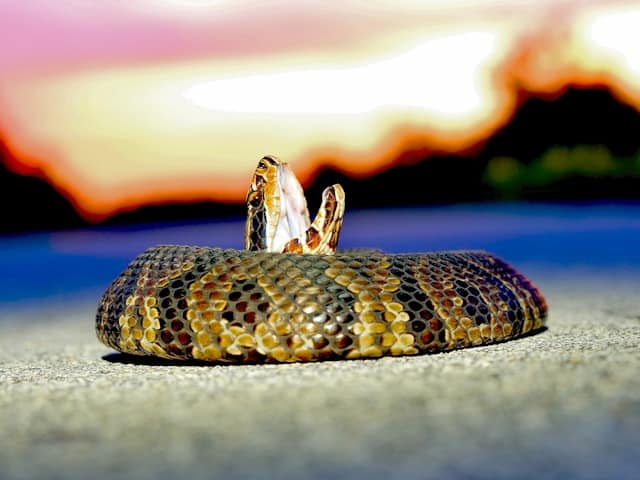
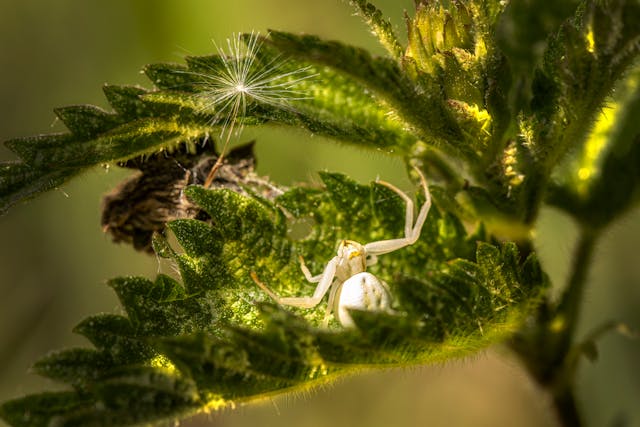
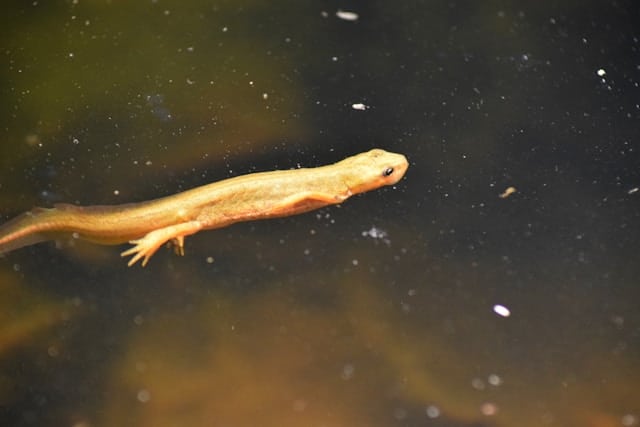
- Cottonmouth snakes live in water and are venomous.
- The Diving Bell Spider is the only species of spider that spends the majority of its time underwater.
- Newts are semi-aquatic amphibians that live semi-aquatic lifestyles.
- Water snakes can stay underwater for up to 90 minutes.
- Some fish like salmon and trout live in the sea but come into the freshwater rivers to reproduce.
- The South China Giant Salamander is the largest amphibian in the world.
- Frogs are born in water and with gills, which are changed into lungs when they are adults.
- Great Blue Herons have frayed feathers on their chest to wipe their dirty beaks.
- Ibises can breathe even when their beak is buried in the sand and mud.
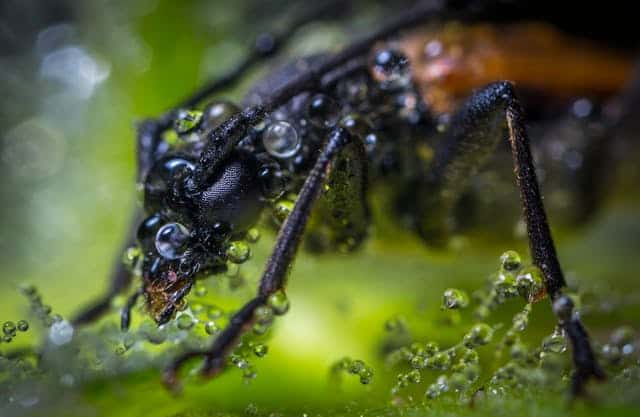
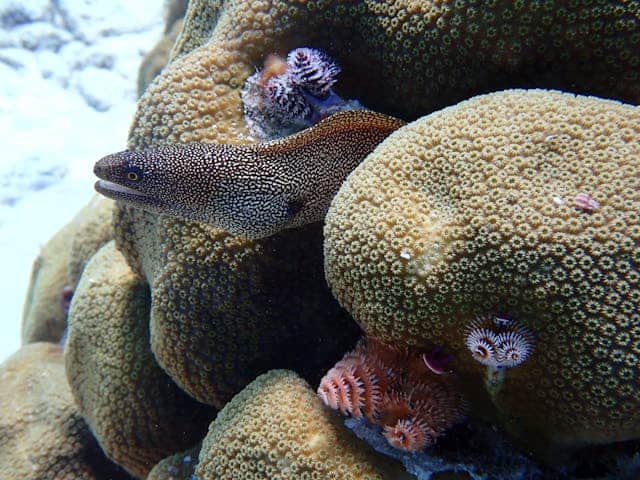
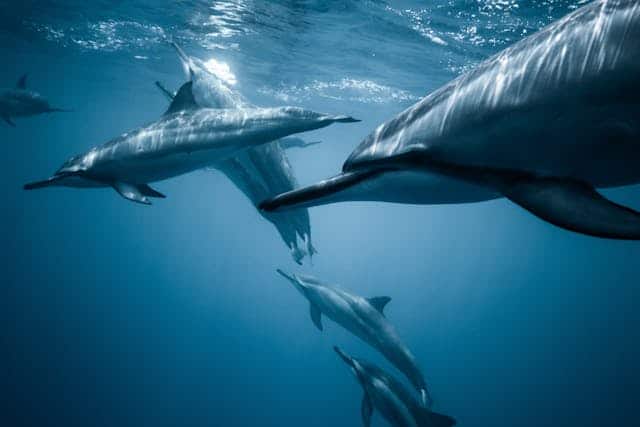
- The Giant Water Bug is the largest tree bug in the world and can eat almost anything, including its babies.
- The Moray Eels look aggressive because to breathe, they are always opening and closing their mouths.
- Dolphins can hear underwater sounds from 14 miles away. They sleep using only half of their brains keeping one eye open, to watch for danger.
- The Blue Whale is the largest animal in the entire planet. It’s as long as three buses and weighs as much as 30 elephants.
- Whales make the loudest sounds on the planet, and their whistle can travel up to 500 miles.
- Parrot fish not only produce a type of cocoon to sleep protected with their mucus, but they are also responsible for producing 85% of the sand that builds up reef islands.
- Seahorses are the only male animals on the planet that birth and care for their babies.
- Many fish are born both male and female, and others can change their sex.
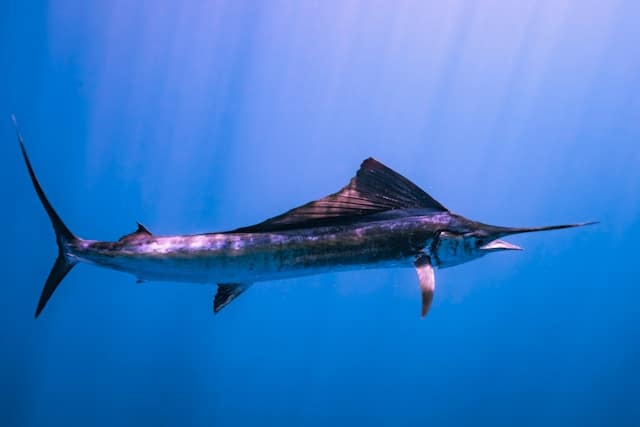
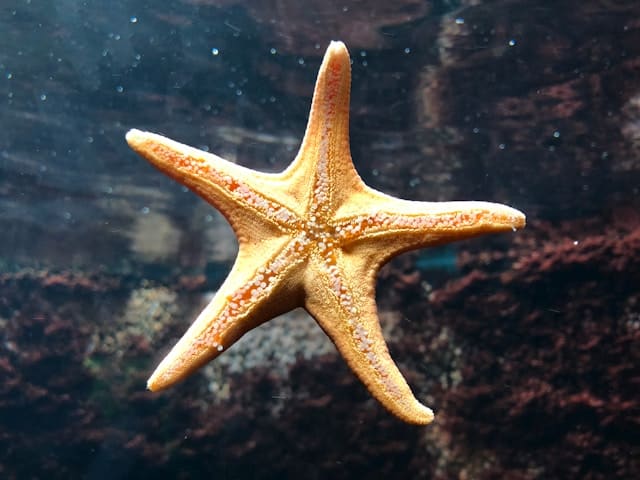
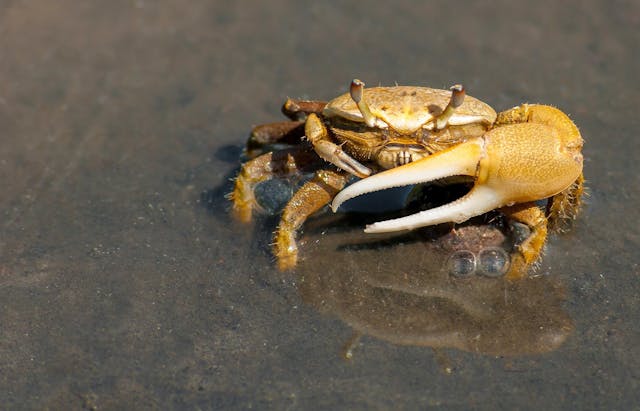
- Sailfish can swim up to 68 miles per hour, which makes them the fastest fish in existence.
- A starfish can regrow its arms when it loses them, and at the end of each arm, it has an eye that allows them to see dark, light, and simple shapes. They can also turn their stomachs inside out.
- Crabs and lobsters taste with their feet, and octopuses with their suckers.
- The larger fish in existence is the whale shark.
- An Electric Eel is called like that because it produces so much electricity that can light up 10 bulbs.
- Octopuses have three hearts and their blood is blue.
- Sea sponges are alive but they are like cleaning sponges with no head, brain, heart, mouth, eyes, lungs, bones, or feelers.
- The Boxfish is called like that because its body is square or triangular defined by a bony structure called the carapace, and only has holes for its eyes, mouth, and fins.
- The Mimic octopus is called like that because it can imitate other marine animals such as sting rays, jellyfish, sea snakes, lionfish, flounder, coral, and even a rock.
- Ribbon eels change colors and sex as they grow. When they are born, they are black males. When they become adults, they turn blue and when they are older, they change to yellow females.
- The Giant Oarfish is the longest fish in the world, and its snake-like body can reach up to 17 meters in length.
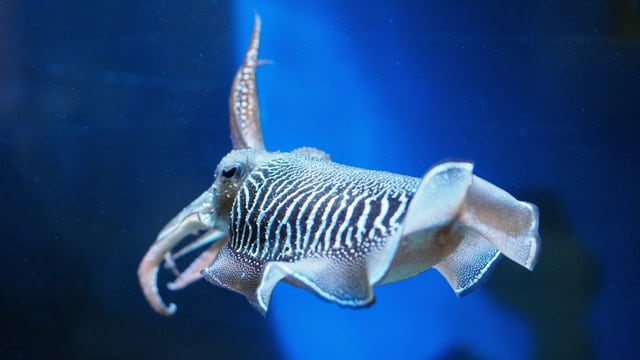
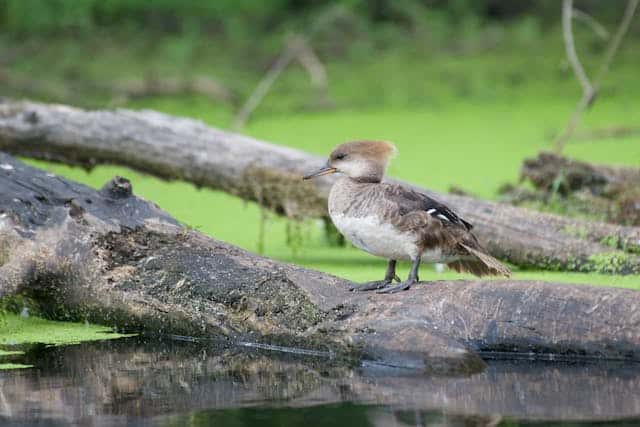
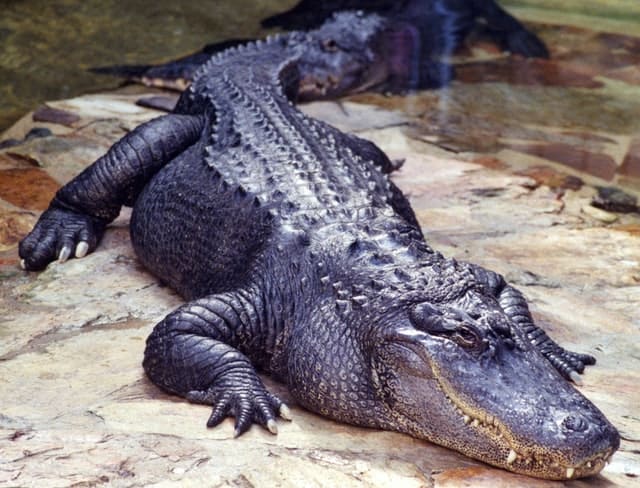
- The Giant Squid has the largest eye in the animal kingdom.
- Mergansers are the fastest duck and can fly at up to 80 mph.
- Alligators can smell blood several miles away.
- Sharks grow more than 20,000 teeth in their lives. When they lose one tooth, they grow another to replace it. Their skin is very rough, because it’s covered with tiny little teeth.
- Loggerhead turtles can hold their breath longer than any other animal on Earth.
- Shrimps have their heart on their heads.
- Pufferfish swallow water to grow their size, as protection.
- Lobsters sometimes can grow a lost claw or eye.
- You can only find pearls once in every 20,000 oysters.
- The Greenland shark can live 200 years.
- Corals had been used to replace bone grafts in humans.
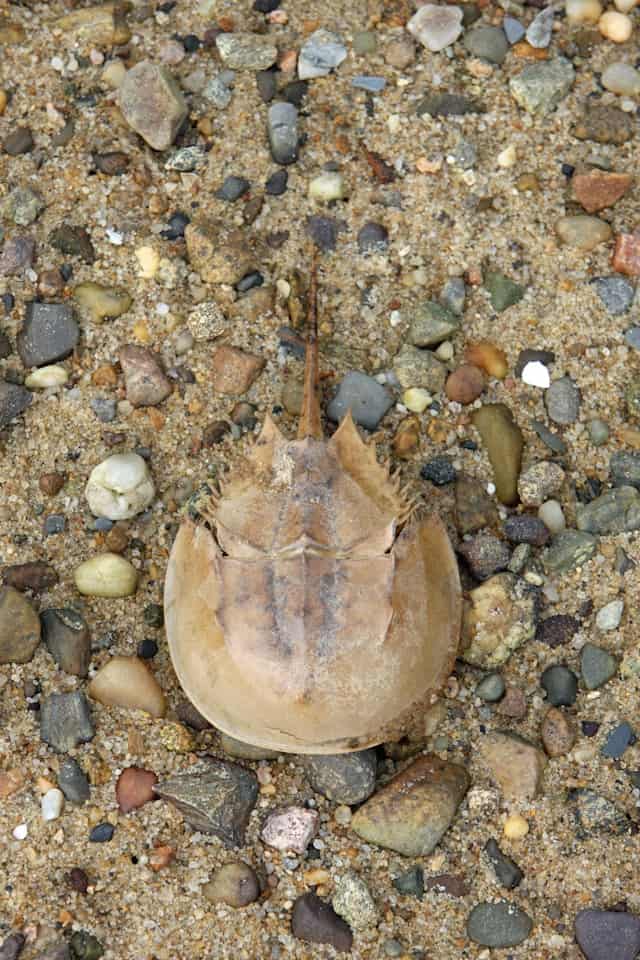
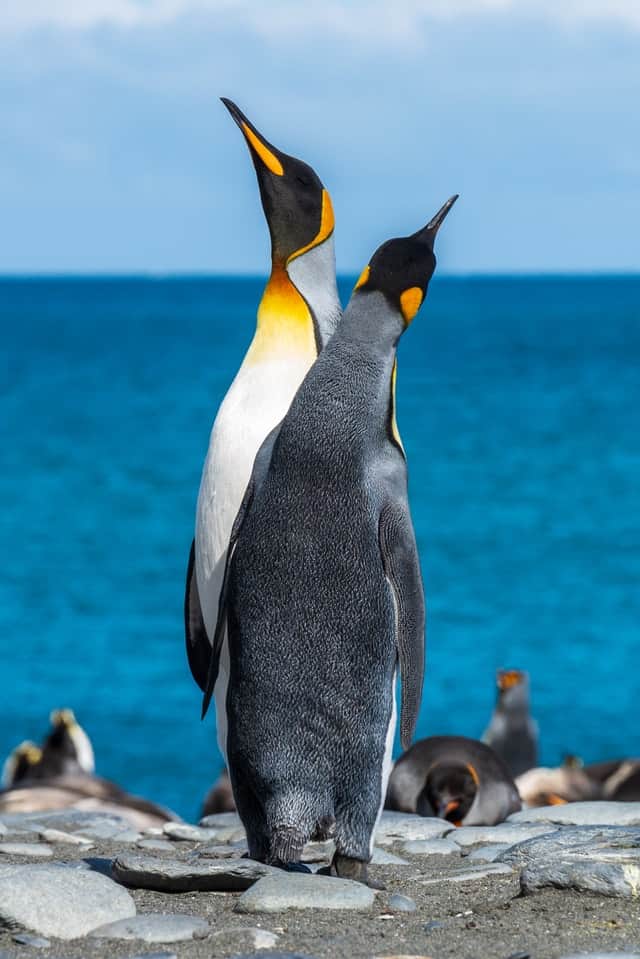
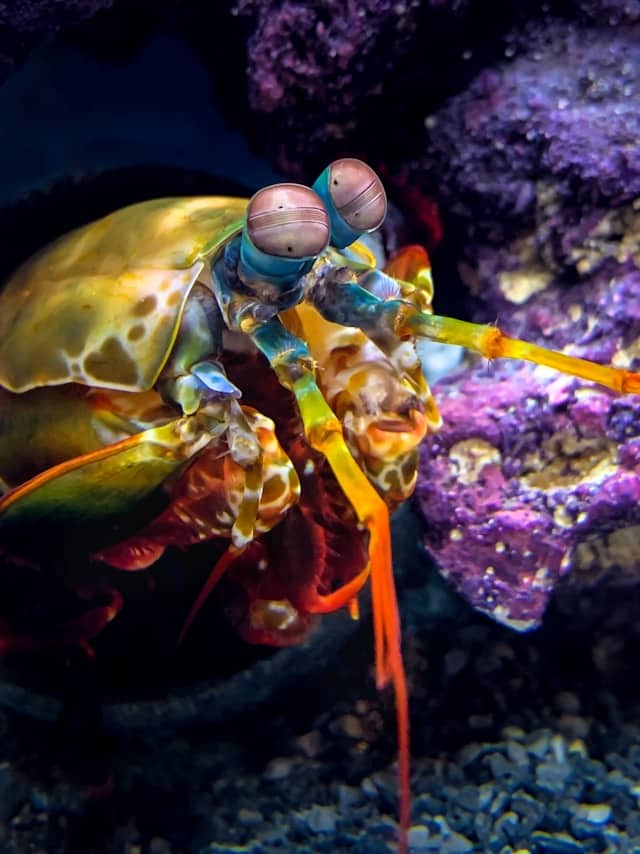
- Horseshoe crabs and sea sponges are living fossils. Horseshoe crabs have been on the planet for more than 300 million years, and sponges for over 600 million years.
- Penguins are aquatic birds and they “fly” underwater reaching a speed up to 25 miles per hour.
- The Peacock Mantis shrimp punches so fast that can vaporize water.
How to Celebrate World Aquatic Animal Day
Celebrating World Aquatic Animal Day and using it as an excuse to learn and educate about aquatic animals doesn’t have to be boring. You can do many fun activities on your own and with your preschoolers to get involved and plant in their hearts and minds the desire to protect these animals and their ecosystems, and avoid a tragic future for the next generations and our planet. Some of the activities you can do are:
- Learn about aquatic animals and the threats they are facing, and pass along the knowledge to your preschoolers, family, and friends.
- Organize a field trip with your children to your local zoo, aquarium, or wildlife sanctuary to learn more about some aquatic animals, how they move, what they look like, what they eat, etc.
- Watch good documentaries about aquatic life such as The Blue Planet, The Fascinating Wildlife in Deep Mountain Lakes, and Our Planet.
- Create a family-friendly charity event to raise funds for underwater wildlife organizations like Oceana, The Ocean Conservancy, The Nature Conservancy, World Wildlife, and Greenpeace.
- Serve snacks and desserts that honor aquatic animals like Goldfish crackers, and gummy fish. You can also find many cute and easy-to-make recipes at Candy Direct, Preschool Education, and Affordable Homeschooling.
- Sing and dance to aquatic animal songs with your preschoolers like Move Like Sea Animals, Under the Sea, Ocean Jam, Big, Blue Whale, and Penguin Dance.
- Do aquatic animal crafts with your children like paintings, murals, and collages. You can find 70 different ones in Craftionary.
- Start a classroom fish tank, a turtle habitat, or raise frogs.
- Make an under-the-water sensory table for your children to play in.
- Get others involved in this fight by participating in or holding educational and promotional events where the community gathers, such as pet adoptions, social media campaigns, etc.
- Volunteer at your local organizations that protect animals and the environment, make posters and participate in written petitions to change or create laws.
- Eliminate and promote the use of single-use plastics.
- Invite an expert from a local wildlife organization to come talk to the children about aquatic life and maybe bring crabs or some freshwater turtles and reptiles, and teach them the difference between animals that live in the ocean, and the ones that live in ponds, marshes, lakes, and rivers.
- Organize an environmental cleaning at your local beach, lake, or river, with your students, their families, and your community in general. This is a great opportunity to teach your kids about pollution, and the importance of keeping the environment free of trash, especially plastics.
- Invite aquatic animals-related games or have friendly competitions such as jumping as frogs, or waddling like penguins. You can also find sea animal games for preschoolers at Everything Preschool.
- Plan math aquatic animals-related activities like counting, sorting fresh water and ocean animals, sorting aquatic animals by type (mammals, amphibians, etc.), doing puzzles, measuring the size of the blue whale on the playground, etc.
- Turn your Dramatic Play area into an aquarium, a pond, or an ocean adding props and dressing clothes.
- Read books to your children.
Books About Aquatic Animals
There are tons of books about aquatic animals, both fictional and non-fictional. You can find many at your local library, used book store, and on Amazon. Below are some aquatic animal-related books I like. You can get fast to any of these Amazon pages if you want to add some to your collection, by just clicking on the title that has my affiliate link.
- Otters! by Hope Aicher. With a collection of full-color photos and fun, interesting facts, this book introduces children to facts about otters, their habitat, characteristics, and other important facts.
- Seahorse by Tim Babler. The beautifully illustrated pages of this book bring the world of seahorses to life, with engaging and informative text that teaches children about different species of seahorses and their unique behaviors, and fun facts that encourage curiosity, independent learning, and exploration.
- Children Encyclopedia of Ocean Life by Claudia Martin. Full of fascinating facts and stunning sea life photography, this book covers everything from the ocean shores to deep sea creatures.
- All About Penguins by Dyan deNapoli. Packed with incredible detail and delightful illustrations, this book teaches children everything there is to know about every penguin species, how they sound like, how they stay warm on land and while swimming, why they can’t fly, and how penguin families raise their chicks.
- Over and Other The Pond by Kate Messner. Children will discover the plants and animals that make up the rich, interconnected ecosystem of a mountain pond.
- Seals! by Hope Aicher. In this book, children will be delighted with stunning photos and fascinating facts about these amazing creatures.
- Fish Faces by Norbert Wu. With full-color photographs and rhythmic text, this book teaches children about more than seventy monstrous, beautiful, friendly, and fierce types of fish.
- Marshes & Swamps by Gail Gibbons. Introduces children to these unique ecosystems what they are, why they’re important, and the birds, fish, and wildlife that make it their homes.
Pin It For Later
If you are in a rush and don’t have time to read the post and download the printable but want to save it for later, pin it to one of your Pinterest boards.
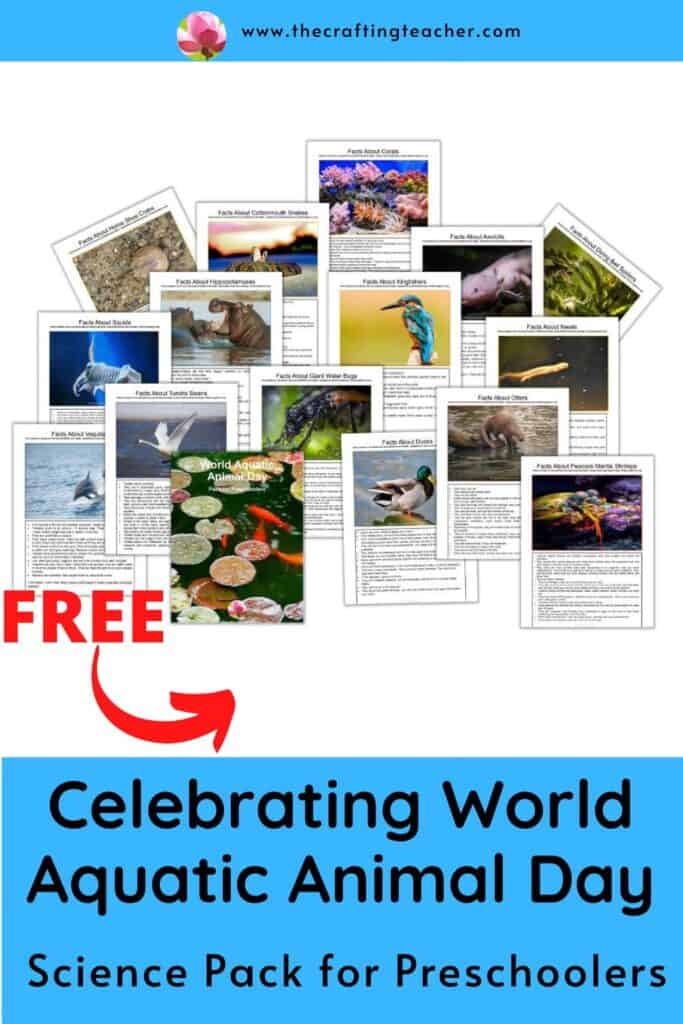
Aquatic animals include a large amount of different species of fascinating creatures and by learning some facts about them, preschoolers can learn to appreciate and protect them, so they can continue playing their important role in our ecosystems.
Don’t forget to download your free World Aquatic Animal Day pack. Just click on the button below, and type your information, for an immediate download.
I hope this information helps you promote in your children, family, and friends a deeper understanding and love for these extraordinary animals, and encourage in them the desire to become their advocates and protectors.
Be happy, safe, and creative. I wish you well.
Love,

P.D. Please let me know if any of these ideas work for you. My goal is to help you in any way.

